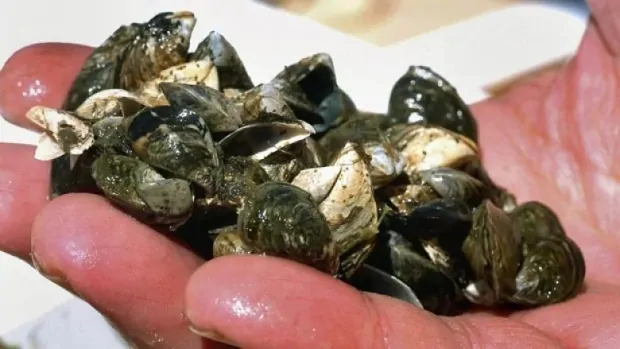'Substantial' number of zebra mussel larvae found along Minnesota shore of Lake of the Woods

Zebra mussel larvae have been found in large numbers in another large Canadian body of water — Lake of the Woods, the world’s 30th-largest freshwater lake.
The Minnesota Department of Natural Resources announced Friday it confirmed the presence of the invasive species at three locations along the U.S. shore of Lake of the Woods, an international body of water with basins in Ontario, Minnesota and Manitoba.
Only the larvae, known as veligers, were found.
“While no adult or juvenile zebra mussels have been reported, the number of larvae is substantial,” the department said in statement.
Zebra mussels are an invasive species that has colonized the Great Lakes, as well as the Red River/Lake Winnipeg drainage system.
The bivalves coat surfaces and can clog water pipes. They also have choked out native species in some places, and their shells litter beaches.
The spread of zebra mussels into Lake of the Woods could have huge ramifications for homeowners, cottagers, fishing and tourism in the area. In addition to potential environmental effects, the invasive species also competes with native mussels for food, growing space and calcium.
But scientists are not certain the species can survive in the lake.
Compared to Lake Winnipeg, which has been infested with zebra mussels since 2013, Lake of the Woods could be less hospitable to the species.
All the lakes in the Canadian Shield typically have low calcium concentrations — and zebra mussels need calcium to build their shells.
“We don’t know if the lake’s water chemistry is conducive to zebra mussel survival,” research scientist Gary Montz said in the Minnesota department of natural resources statement. “It is possible that calcium levels or other factors might prevent propagation.”
Lake of the Woods flows through the Winnipeg River into Lake Winnipeg. The lake’s Minnesota waters are shallower and less rocky than the Canadian portions of the lake. The Canadian Lake of the Woods area includes the city of Kenora and most of the lake’s developed cottage areas.
A single zebra mussel veliger was found in 2018 in Shoal Lake, a bay of Lake of the Woods that serves as the source of Winnipeg’s drinking water.
Unlike sandy Lake Winnipeg, Shoal Lake and Lake of the Woods have a lot of exposed granite that could serve as zebra mussel habitat.
The City of Winnipeg has been preparing for the prospect of zebra mussels in Shoal Lake since the 1990s. Zebra mussels can grow on screens, fittings and pipes at the aqueduct intake, Winnipeg water services manager Tim Shanks said in 2018.
The city has taken steps to protect its water supply and has set aside $1.2 million to protect the Winnipeg aqueduct intake pipe and other aspects of its facility at Indian Bay on Shoal Lake, a city engineer told council in 2017.
The city could add chlorine to the aqueduct intake to prevent mussels from growing in the pipe and it also has plans to scrape out the mollusks if need be, he said.





